Did you know that over 50% of motorcycle accidents in autumn are related to tire issues ? As the crisp air of autumn settles in, so do unique hazards: wet leaves, varying temperatures, and unpredictable road surfaces. This changing landscape makes a thorough motorcycle tire check autumn not just wise—but essential. In this comprehensive guide, you’ll discover practical steps, must-know checklists, and expert tips to safeguard every autumn ride.
Autumn Motorcycle Tire Check: Essential for Safe Riding
The autumn months present motorcycle riders with beautiful scenery but also sudden risks such as slippery due to wet leaves and shifting road surface conditions. Performing a detailed motorcycle tire check autumn is your first line of defense. Let’s face it—when temperatures drop and daylight hours shorten, the combination of cold weather and damp roads increases the chance for loss of traction. Practical examples show that something as minor as under-inflated tires or missed signs of wear can turn a scenic ride into a hazardous journey. To ensure safer riding through the ever-changing conditions of the season, a comprehensive check is a non-negotiable part of your autumn routine.
Consider the impact of early morning dew and falling leaves —both of which can swiftly alter the state of the road surface . Proper tire care is crucial not only for maintaining grip in wet conditions but also for prolonging the life and performance of your motorcycle tires . By giving attention to your tires at the start of the riding season, you proactively minimize risks, sidestepping roadside emergencies and ensuring that every ride is a pleasure. Make this autumn the season you prioritize tire safety on every ride.
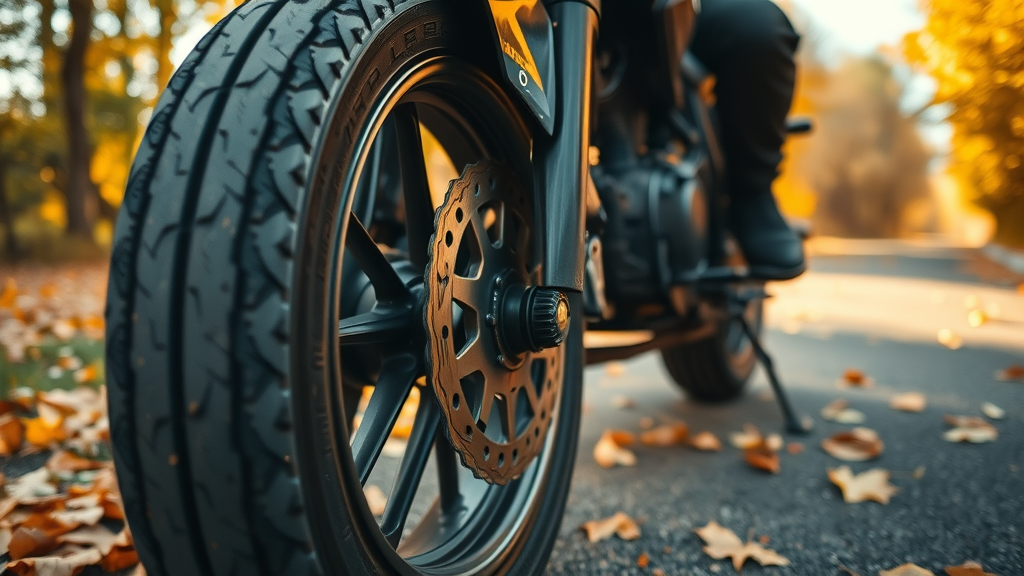
Did You Know? Over 50% of Motorcycle Accidents in Autumn Involve Tire Issues
Startling as it may sound, a significant percentage of all autumn motorcycle accidents are traced back to avoidable tire problems. This alarming fact underlines why tire pressure , tread depth, and sidewall condition are more than just maintenance—they’re a matter of safety and even survival. By recognizing the unique risks of the time of year , you gain the compelling motivation to act before it’s too late.
Prevention is always preferable to recovery, especially when it comes to a critical safety component like your motorcycle tire. Riders who regularly check your tire in autumn report fewer accidents and smoother, more predictable rides. Take this seriously—not just for yourself, but for everyone who shares your route.
Why a Motorcycle Tire Check in Autumn Matters
Autumn brings a perfect storm of factors that challenge even the most experienced riders. From the accumulation of wet leaves to cooler days that can cause tire pressure to fluctuate, the need for a routine motorcycle tire check autumn becomes increasingly important. During this season, your tires must adapt to varying temperatures, moisture, and sometimes unseen debris, which can compromise performance or safety if left unchecked.
Neglecting tire care during the autumn riding season is risky. Low motorcycle tire pressure can reduce both traction and responsiveness, especially as pavement cools. Likewise, tires with worn treads are more prone to slipping on damp or leaf-littered road conditions . Making a habit of checking your tires before every ride isn’t just for peace of mind—it can be the critical difference between a smooth stop and a dangerous slide.
-
Improved safety and stability in unpredictable autumn weather
-
Enhanced tire pressure retention for optimal handling
-
Detection of signs of wear and early tire aging
-
Extended lifespan for motorcycle tires due to proactive maintenance
-
Reduced risk of breakdowns in remote locations
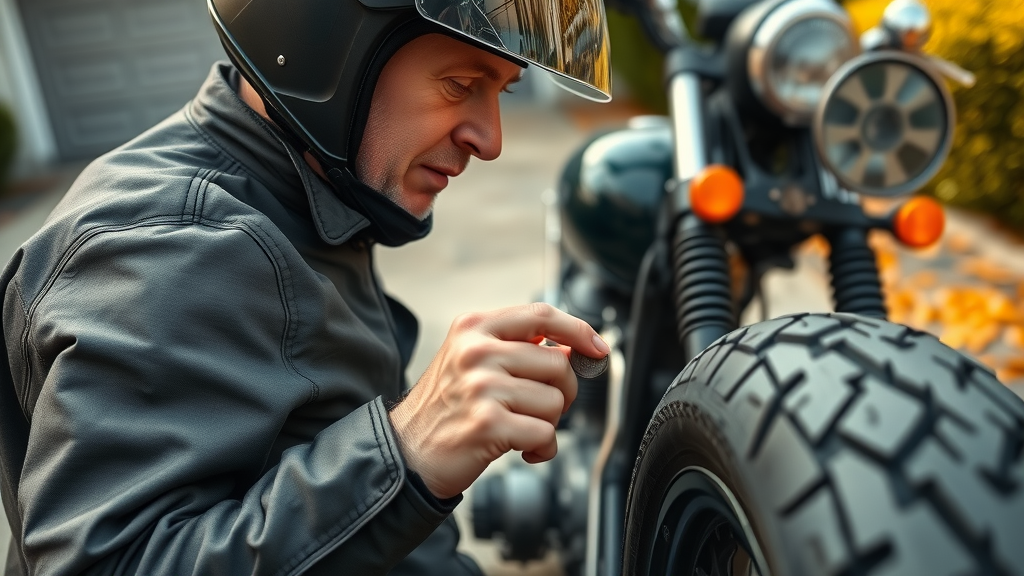
Motorcycle Tire Safety: The Fundamentals for Autumn
The foundation of autumn motorcycle safety begins with understanding core tire care fundamentals. Every rider, regardless of experience or riding style , needs to know how to objectively assess tire condition and performance. This means knowing the signs of tire aging, monitoring for physical damage, and maintaining the ideal tire pressure for your specific motorcycle.
Changes in weather conditions —like colder temperature swings between day and night—demand regular checks. A little diligence goes a long way. Get into the routine of inspecting before each trip, focusing on critical areas like tread wear, tire sidewalls, and valve stems. With proper maintenance and a systematic approach, you’ll enjoy longer-lasting tires and a much safer autumn riding experience.
|
|
Key Motorcycle Tire Check Autumn Point Checklist |
|
Check Point |
What to Look For |
|---|---|
|
Tread Depth |
Minimum 2/32” depth; visible tread wear indicators |
|
Tire Pressure |
Refer to owner’s manual; check when cold |
|
Inflation |
Consistent PSI in both tires, adjust for temperature changes |
|
Age |
Replace tires older than 5-6 years |
|
Sidewall Condition |
Look for cracks, cuts, or bulges |
|
Valve Integrity |
No leaks, cracks, or valve stem rot |
How to Check Your Tire Pressure for Autumn Rides
Checking your motorcycle tire pressure is the simplest step you can take for autumn safety. Tire pressure directly influences your grip, braking, and ability to navigate unexpected hazards like wet conditions or sudden drops in temperature. A well-inflated tire provides maximum surface contact with the road, giving you reliable traction whether you’re cruising on open highways or winding through suburban neighborhoods.
To ensure accuracy, always check your tire pressure when the tires are cold—that is, before you start riding. This ensures you get an accurate reading, as pressure rises once the tires heat up during use. Use a high-quality, motorcycle-specific gauge and always follow your motorcycle manufacturer’s recommended PSI for both front and rear tires. Checking tire pressure should be a routine step, not an afterthought, especially as temperatures shift throughout the autumn riding season.
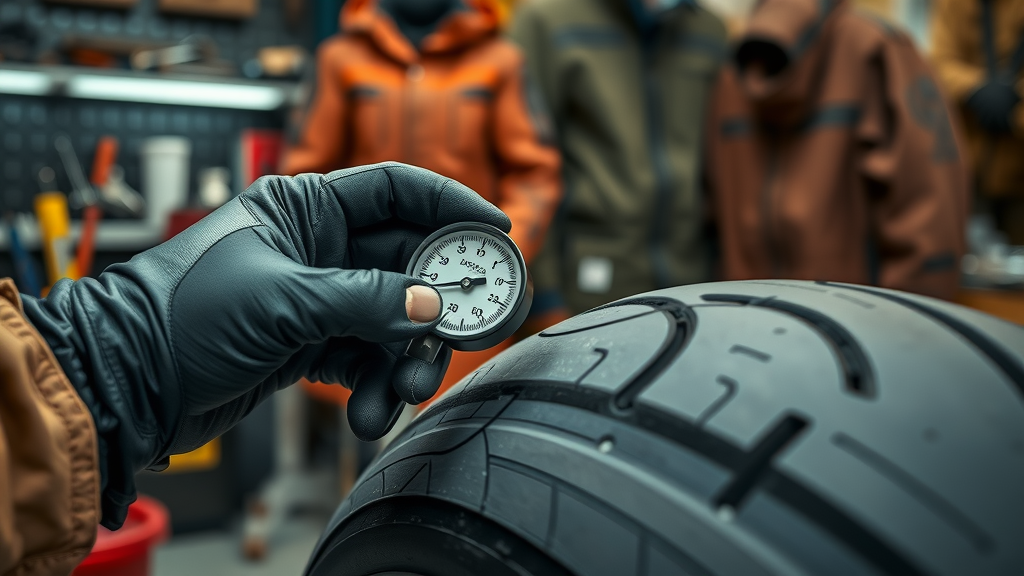
Correct Tire Pressure Guidelines for Different Motorcycle Tires
Different motorcycles require different tire pressures. For example, sport bikes may need anywhere from 32-42 PSI, while cruiser or touring models might require slightly lower or higher values, depending on load and manufacturer specifications. Don’t rely solely on the tire’s sidewall marking; check your owner’s manual for precise numbers. Remember, improperly inflated tires—either over or under—can lead to uneven wear, poor braking, and a higher risk of losing control on damp or leaf-littered roads.
Ignoring proper inflation can cause tires to wear prematurely along the edges (under-inflation) or in the center (over-inflation). Both conditions can increase your risk, particularly during autumn weather changes. When in doubt, *consult a trusted professional* before embarking on longer journeys.
Practical Steps: How to Check Your Tire Pressure Accurately
Before every ride, follow these steps for a spot-on motorcycle tire pressure check:
-
Park your motorcycle on level ground. Let the tires cool down for at least an hour if you've just returned from a ride.
-
Remove the valve cap and use a digital or analog pressure gauge suited for motorcycles. Press firmly, ensuring no hissing or escaping air for the most accurate reading.
-
Compare your gauge’s reading to the PSI range listed in your owner’s manual, not what’s printed on the tire’s sidewall.
-
Adjust as necessary. If the tire pressure is too low, add air in small increments. If it’s too high, deflate until you reach the target PSI. Always double-check your work.
-
Replace the valve cap tightly and repeat the process for the second tire.
Maintaining proper tire pressure, especially in autumn’s fluctuating weather conditions , is one of the easiest and most effective ways to ensure a safe ride.
The Importance of Tire Inflation for Autumn Motorcycle Safety
Maintaining proper tire inflation is equally important as checking pressure. Under-inflated tires build up excess heat, which weakens structural integrity and increases your risk of a blowout. Over-inflated tires reduce the amount of tire surface that contacts the pavement, which can spell disaster when traversing road surfaces littered with slick leaves.
Many autumn accidents can be traced back to neglected tire inflation checks. Tire pressure naturally decreases as temperatures drop, so a reading that was perfect in summer may be dangerously low in October. Take two minutes before each ride to prioritize inflation, especially during this time of year. Prevention is always easier than dealing with a roadside repair in fading daylight hours.
"A neglected tire in autumn is a risk to every ride. Prevention starts with a simple pressure check." – Motorcycle Safety Expert
How to Check Your Tire for Wear, Damage, and Aging in Autumn
Tire aging and physical wear are silent threats—easy to miss but catastrophic if left unchecked. Begin by visually inspecting the tread for uneven wear patterns, cracks, or foreign objects. Sidewall bulges, dry rot, and embedded debris are warning signs that your motorcycle tires need attention immediately.
With each passing season, tire rubber becomes less elastic and more prone to stress fractures or punctures. If you ride year-round or store your motorcycle during the off-season, always inspect for flat spots or dry rot before venturing out. By establishing a habit of motorcycle tire check autumn at the start of every season, you greatly reduce the risk of tire-related breakdowns and accidents.
Identifying Tread Depth: Understanding the Penny Test for Motorcycle Tires
One of the simplest ways to determine if your tire has enough tread for safe autumn riding is the classic ‘penny test.’ Insert a penny into several tread grooves across the tire, with Lincoln’s head facing down. If you see the top of Lincoln’s head at any point, your tread is too shallow—replace the tire. Tread below 2/32” is inadequate for handling wet conditions and poor road surfaces common in fall.
Riding in autumn’s unpredictability with insufficient tread is asking for trouble. Adequate tread channels water away from the tire, helping maintain grip even when crossing wet leaves or early morning dew. And don’t forget—if the penny test signals new tires, act before the next ride. Waiting is a gamble not worth taking.
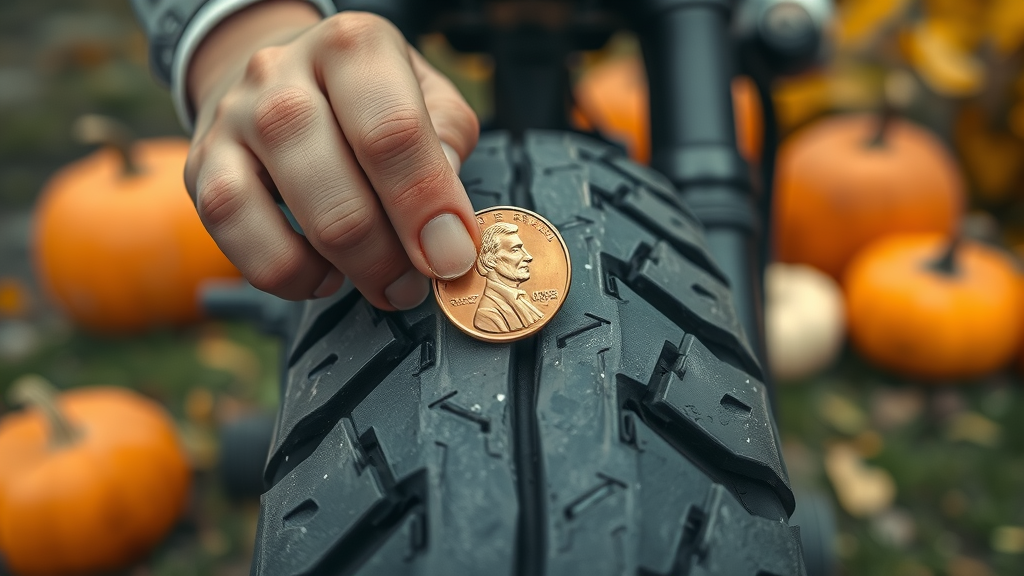
Checking the Year and Age of Your Motorcycle Tire
A tire’s age plays a pivotal role in its safety, even if it appears visually sound. Hidden in the sidewall is the DOT code, which ends with a four-digit number indicating manufacture week and year. For example, ‘2519’ means the tire was produced in the 25th week of 2019. Motorcycle tires are recommended for replacement every five or six years, regardless of visible wear, due to rubber degradation.
This check is particularly vital if the motorcycle is used primarily during the riding season and stored for an extended period. Rubber loses flexibility over the years, especially when subjected to alternating warm days and cold nights typical of autumn. Don’t take chances—replace tires that have aged out, even if the tread appears sufficient.
How to Prepare Your Motorcycle Tire and Riding Gear for Falling Temperatures
Tire checks go hand-in-hand with preparing your riding gear for the colder season. The shift in temperature doesn’t just affect tire performance—it can also compromise your comfort and alertness. Equip yourself with insulated gloves, moisture-resistant jackets, and boots with strong grip for wet or leaf-strewn ground. A clear visor or anti-fog solution is vital for those early morning rides where humidity and chill meet.
Prepare your motorcycle for autumn's cold by checking your brakes, brake pads , and brake fluid level . Don’t overlook these components; a comprehensive check of both your bike and personal gear not only extends their lifespan, but maximizes your safety and enjoyment on every autumn ride.
-
Inspect helmet, gloves, boots, and jackets for insulation and weather resistance
-
Ensure all reflective surfaces and lights are clean and working
-
Check heated grips or liners, if equipped, for proper function
-
Replace or repair any worn-out or missing riding gear elements
-
Test brake pads and brake fluid before departing
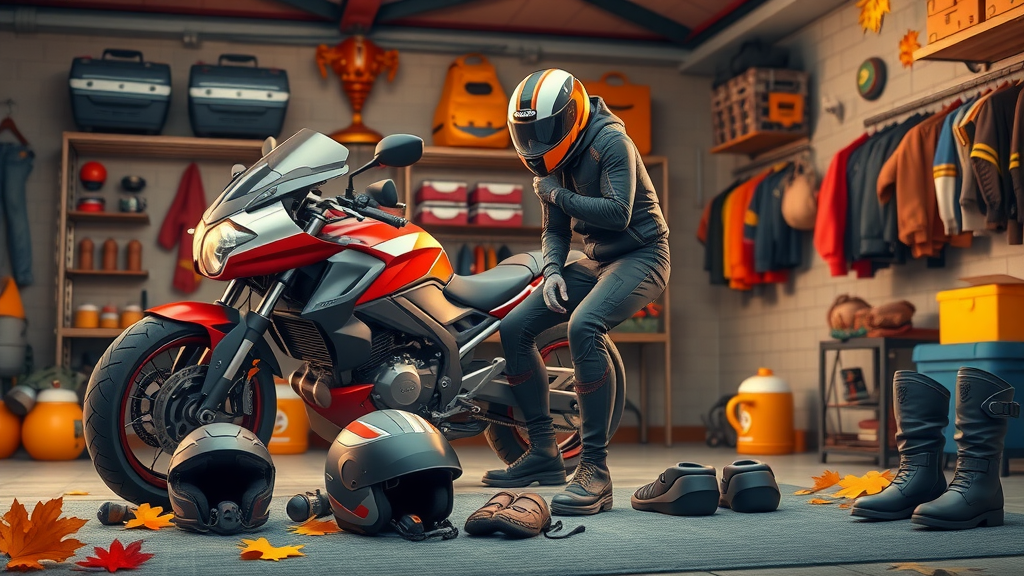
Electrical System and Related Safety Checks for Autumn Riding
While tires are top priority, don’t underestimate the importance of your motorcycle’s electrical system when autumn arrives. Shorter days and unpredictable weather conditions demand reliable headlights, taillights, and turn signals. Check all bulbs, replace any that are dim or not working, and confirm that high and low beams function correctly, especially during low-visibility conditions common this time of year.
Batteries can lose charge quicker in lower temperatures, so test your battery’s voltage and ensure it’s secured tightly. Loose connections or frayed wires can lead to electrical failures at the worst possible times. Finally, confirm that heated grips, auxiliary lighting, and other electronic accessories function as expected—each plays a role in keeping every autumn ride safe and comfortable.
Top 5 Signs Your Motorcycle Tire Needs Attention This Autumn
Stay alert for these key warning signs that your motorcycle tire demands immediate action. Ignoring the subtle signals can amplify risk, particularly during autumn’s unpredictable shifts in temperature and road quality.
-
Uneven Tread Wear – Indicates improper tire pressure or misalignment, which can compromise handling on slick autumn roads.
-
Visible Damage – Cuts, punctures, or foreign objects embedded in the tire can lead to sudden deflation or a dangerous blowout.
-
Cracks – Age-related stress shows as cracks on sidewalls or between treads, warning the tire is at the end of its safe life.
-
Loss of Pressure – Repeated need to add air suggests a slow leak, which can worsen on colder days or longer rides.
-
Aged Tires – Even with good tread, tires older than 5-6 years are prone to sudden failure. Check the DOT code to confirm manufacturing date.
Watch as an expert mechanic walks you through an autumn-focused tire inspection—identifying crucial check points and demonstrating practical, real-world safety techniques. This video shows close-ups of tire tread, valve testing, and tips for maximizing motorcycle tire safety throughout the autumn season.
Learn the correct way to use a tire pressure gauge—get accurate readings every time, no matter the outdoor temperature. This step-by-step video is perfect for both new riders and seasoned pros aiming for top-notch autumn tire care.
FAQs About Motorcycle Tire Check Autumn
When should you check your motorcycle tires?
You should check your tire before every ride—especially during autumn, when temperature shifts, wet conditions, and falling leaves can rapidly change road surface safety. Adding this five-minute check to your routine helps keep you ahead of potential problems, reduces the risk of tire failure, and promotes safer riding all season long.
How to check the year on a motorcycle tire?
Examining your tire’s sidewall, locate the DOT code. The last four digits represent the week and year the tire was manufactured (e.g., "2318" means 23rd week of 2018). If your tire is over 5-6 years old, regardless of tread, it’s time to replace it—especially before autumn rides, which demand peak performance.
Should your tire be cold when checking?
Yes, always check your tire pressure when the tires are cold—that means before you’ve ridden or at least an hour after your last ride. Warm tires yield higher pressure readings, so a cold check gives the most accurate and meaningful results for fall weather.
What is the penny test on motorcycle tires?
The penny test is a quick way to assess tread depth on motorcycle tires . Insert a penny, Lincoln’s head down, into the center tread groove. If you can see the top of Lincoln’s head, your tread is too low for safe autumn riding and you should replace the tire without delay.
Key Takeaways for Your Next Motorcycle Tire Check Autumn
-
Tire Pressure: Check before every autumn ride for reliable grip and braking power.
-
Tread Depth: Use the penny test; replace if below 2/32”.
-
Inflation: Adjust for lower temperatures and fluctuating weather conditions.
-
Year-Age Check: Replace tires older than 5-6 years, regardless of mileage.
-
Autumn-Specific Care: Prepare both bike and riding gear for cold, wet, and early nightfall.
Risk Reduction: Motorcycle Tire Check Autumn and Accident Prevention
Thoroughly checking your tires each autumn slashes your risk of unexpected accidents, keeping you alert, stable, and responsive no matter how unpredictable the changing road conditions become. Motorcycle tire failure—be it from low tread, improper tire pressure , or age—remains one of the top causes of autumn riding incidents. Make the commitment: a simple investment of attention every autumn pays off every single time you ride.
As the days shorten and weather conditions become more challenging, riders who prioritize motorcycle tire check autumn not only dodge danger—they set a higher standard for proper maintenance and personal safety all year long. Be the rider who arrives safely, every time.

"Regularly inspecting your motorcycle tires every autumn is an investment in your safety and the performance of your ride." – Industry Leader
Contact for Personalized Motorcycle Tire Check Autumn Advice
Ready for a comprehensive, personalized tire check?
Call Nasty Performance Motorcycle Shop Today: 847-458-4858 . Let our experts guide you through every detail—because your autumn ride should always be memorable for the right reasons.
As autumn approaches, ensuring your motorcycle tires are in optimal condition is crucial for safe riding. The article “Essential Fall Riding Maintenance Checklist for Motorcyclists” provides comprehensive guidance on tire maintenance during the fall season, emphasizing the importance of checking tread depth, tire pressure, and signs of wear to adapt to changing road conditions. ( twowheeltribe.com ) Additionally, “Maintaining Motorcycle Tires: Tips for Longevity and Safety” offers valuable insights into regular inspections for wear and tear, proper cleaning techniques, and the significance of maintaining optimal tire pressure to enhance both safety and tire lifespan. ( hongyuantyre.com ) By consulting these resources, riders can equip themselves with the knowledge needed to navigate autumn roads safely and effectively.
 Add Row
Add Row  Add
Add 
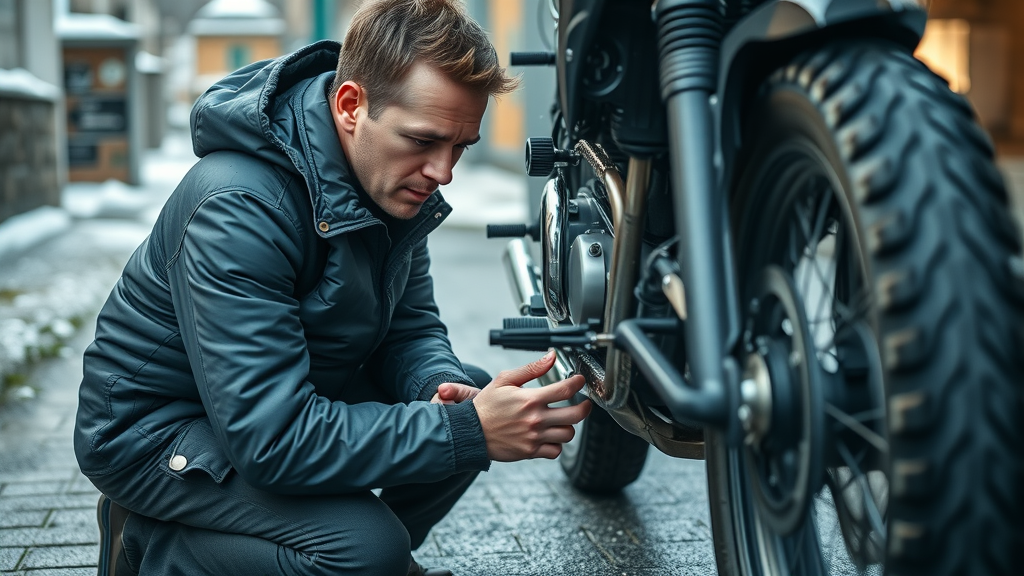


Write A Comment